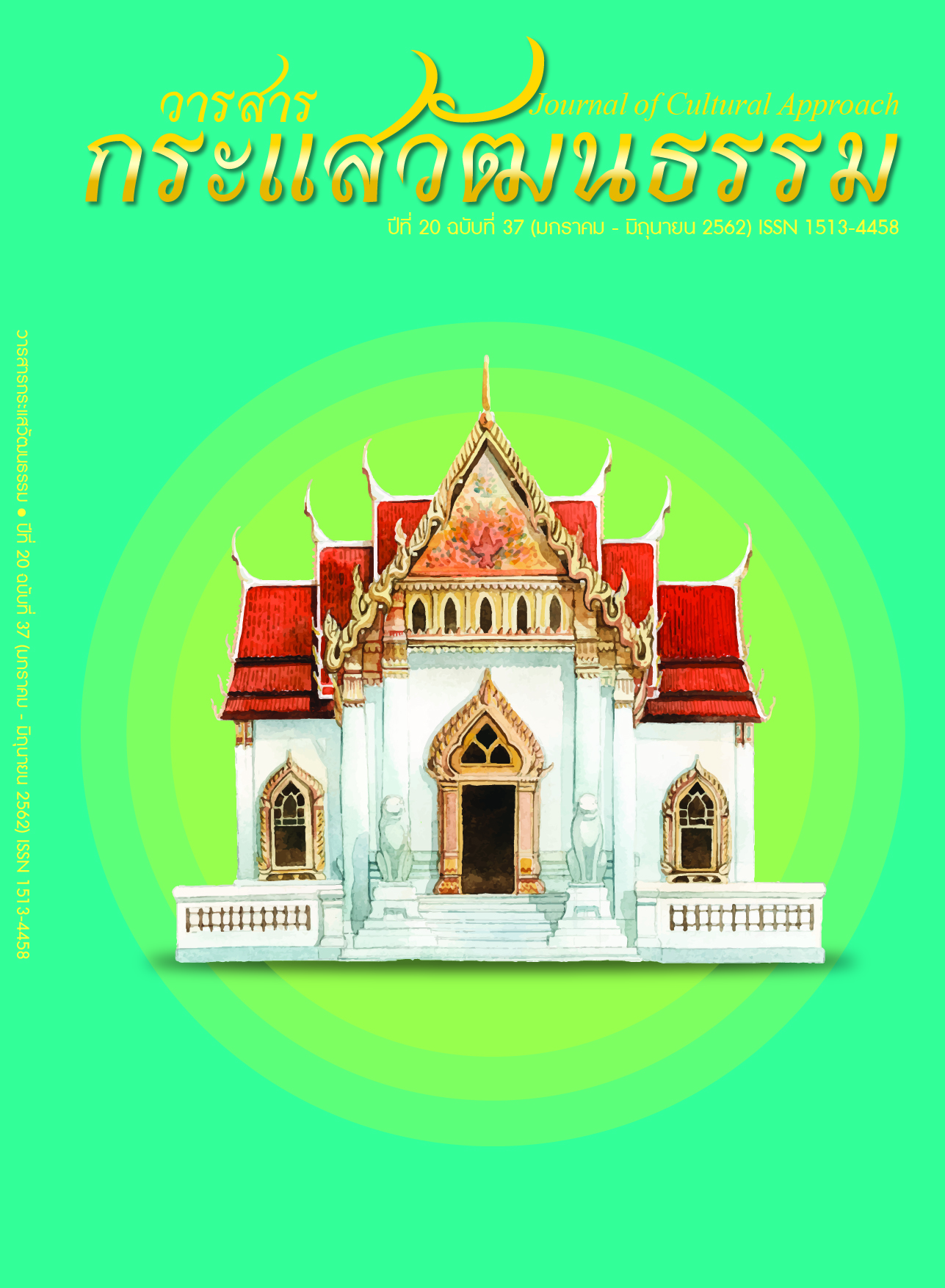การถ่ายโอนความรู้วัฒนธรรมดนตรีของกลุ่มชาติพันธุ์ชาวเลในจังหวัดสตูล
Main Article Content
บทคัดย่อ
การวิจัยนี้ มีวัตถุประสงค์เพื่อศึกษาการถ่ายโอนความรู้วัฒนธรรมดนตรีของกลุ่มชาติพันธุ์ชาวเลอูรักลาโว้ยในจังหวัดสตูล ใช้วิธีวิจัยเชิงคุณภาพ และใช้ระเบียบวิธีวิจัยแบบดนตรีชาติพันธุ์วิทยา ใช้กลุ่มประชากรคือ นักดนตรี นักแสดงชาวเลอูรักลาโว้ยในหมู่เกาะบุโหลน และเกาะหลีเป๊ะ เป็นหลักจำนวน 5 คน มีผู้ให้ข้อมูลภาพรวมคือ ผู้นำชุมชนและคนในเกาะทั้ง 2 เกาะที่เกี่ยวข้องโดยให้ข้อมูล ทั้งทางตรงและทางอ้อม เป็นกลุ่มรองจำนวน 10 คน วิเคราะห์ข้อมูลเชิงคุณภาพโดยประมวลผลเชิงเนื้อหาและเปรียบเทียบข้อมูล ผลการวิจัยพบว่า ทุนความรู้ด้านวัฒนธรรมดนตรีของกลุ่มชาติพันธุ์ชาวเลอูรักลาโว้ยในจังหวัดสตูลมีอยู่ในตัวบุคคลวัยกลางคนขึ้นไปของทั้ง 2 เกาะ และถ่ายโอนความรู้สู่เยาวชนวัยเรียนเป็นหลัก โดยแรกเริ่มในหมู่เกาะบุโหลนจะมีทั้งทุนทางดนตรีและการเต้นรำ ส่วนในเกาะหลีเป๊ะมีเพียงการเต้นรำเท่านั้น การถ่ายโอนทุนทางวัฒนธรรมจึงมี 2 รูปแบบคือ การถ่ายโอนความรู้ภายในเกาะและการถ่ายโอนความรู้ระหว่างเกาะ โดยความรู้และการปฏิบัติในเรื่องวัฒนธรรมดนตรีมีการพัฒนาและเปลี่ยนแปลงไปตามสภาพแวดล้อมและปัจจัยทางสังคม ส่งผลให้วิถีดนตรีและการแสดงมี 2 รูปแบบ คือ การแสดงเพื่อชุมชนตามวิถีวัฒนธรรมเดิม และการแสดงเพื่อตอบสนองความต้องการของนักท่องเที่ยว
Article Details
Proposed Creative Commons Copyright Notices
1. Proposed Policy for Journals That Offer Open Access
Authors who publish with this journal agree to the following terms:
- Authors retain copyright and grant the journal right of first publication with the work simultaneously licensed under a Creative Commons Attribution License that allows others to share the work with an acknowledgement of the work's authorship and initial publication in this journal.
- Authors are able to enter into separate, additional contractual arrangements for the non-exclusive distribution of the journal's published version of the work (e.g., post it to an institutional repository or publish it in a book), with an acknowledgement of its initial publication in this journal.
- Authors are permitted and encouraged to post their work online (e.g., in institutional repositories or on their website) prior to and during the submission process, as it can lead to productive exchanges, as well as earlier and greater citation of published work (See The Effect of Open Access).
Proposed Policy for Journals That Offer Delayed Open Access
Authors who publish with this journal agree to the following terms:
- Authors retain copyright and grant the journal right of first publication, with the work [SPECIFY PERIOD OF TIME] after publication simultaneously licensed under a Creative Commons Attribution License that allows others to share the work with an acknowledgement of the work's authorship and initial publication in this journal.
- Authors are able to enter into separate, additional contractual arrangements for the non-exclusive distribution of the journal's published version of the work (e.g., post it to an institutional repository or publish it in a book), with an acknowledgement of its initial publication in this journal.
- Authors are permitted and encouraged to post their work online (e.g., in institutional repositories or on their website) prior to and during the submission process, as it can lead to productive exchanges, as well as earlier and greater citation of published work (See The Effect of Open Access).
เอกสารอ้างอิง
[2] Chaiboon, Pakamas. (2016). Thub Rhythmic Patterns in Shadow Puppet Performances: The Case of Thub Musicians Performing in the Ensembles of National Artist Puppeteers. Journal of Cultural Approach. 17(32), 44–58.
[3] Choeychuenjit, Sumroeng. (2008). Tsunami Impact – the World of Morgan, Morglan and Urak Lawoi Sea Gypsies after the Waves. Chiang Mai: Heinrich Böll Found.
[4] Granbom, A. C. (2005). Urak Lawoi. Lund: Lunds University.
[5] Hogan, D. W. (1972). Men of the Sea: Coastal Tribes of South Thailand’s West Coast. Journal of the Siam Society, 60(1), 205–235.
[6] Jaroonthong, Darunai. (2007). History of Urak Lawoi in Lipe Island, Satun Province, A.D. 1950–2006. Dissertation, Master of Arts Thesis in History, Graduate School, Silpakorn University.
[7] Srilamul, Yaowanit. (1998). A Study on Cultures Concerning Basic Living Factors of Chaw Lae in Lee Peh, Tambon Koh Sarai Amphoe Muangsatun, Changwat Satun. Dissertation, Master of Arts Thesis in Thai Studies, Graduate School,Thaksin University.
[8] Taleluk, Ramhan. (2012, January 7). Interview. The Musician of Urak Lawoi in Bulon Archipelago.
[9] Ungpho, Rewadee. (2013). Urak Lawoi Sea Gypsy Music Culture in Bulon Archipelago, Satun Province. Bangkok: The Chaipattana Foundation.
[10] Wongbusarakam, Supin. (2007). The Urak Lawoi’ of the Adang Archipelago, Thailand. Bangkok: Themma Group.


